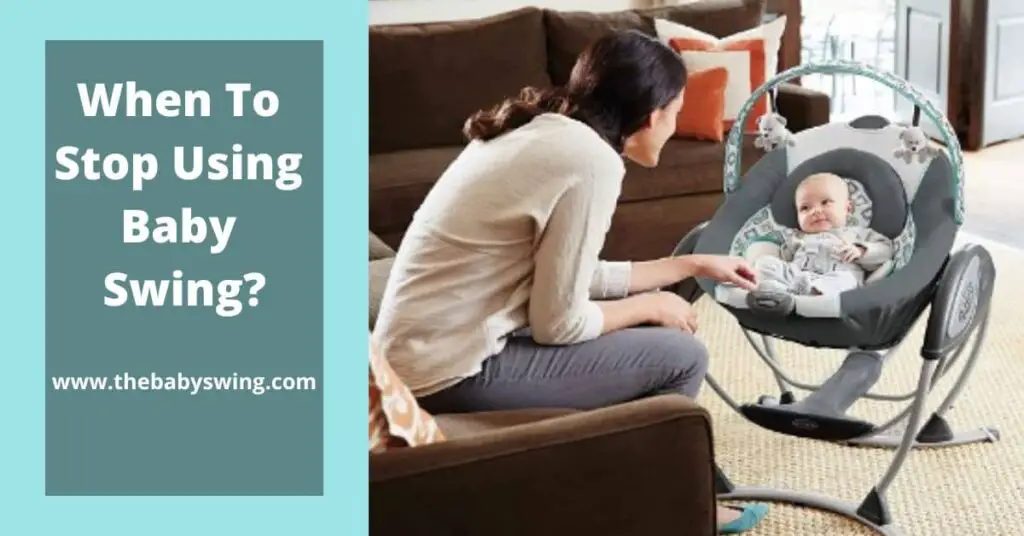Last Updated on July 18, 2023
When is the right time to stop using a baby swing? This is a question that many parents ask themselves. The answer to this question depends on a variety of factors, such as the baby’s age and weight.
In this blog post, we will discuss when it is appropriate to stop using a baby swing. We will also discuss the pros and cons of using a baby swing and provide tips for transitioning your child from the swing to other forms of stimulation. So, keep reading!

- When can a baby start using a swing?
- How long can a baby stay in a swing?
- When to stop using baby swings?
- When do babies stop liking swings?
- What about premature babies?
- What are the weight and age limits of a baby swing?
- Some signs that your baby is emotionally ready to leave the swing include:
- What does the AAP say about baby swings?
- Why Do Babies Need Swings?
- Can a baby sleep in a swing?
- Pros and Cons of Using Baby Swing
- Baby Swing Safety Tips for parents:
- FAQs
- Wrap up
When can a baby start using a swing?
When can a baby go in a baby swing? Generally, a baby can use a swing right from birth. But it’s better to wait for a few weeks until the baby’s umbilical cord falls off. It’s because the swinging might cause the cord to become entangled. After a few weeks, you can start using the swing slowly at first and then gradually increase the speed.
But don’t forget most baby swings come up with a certain weight limit. You should never swing a baby that’s over the weight limit as it might cause serious injury. So, always check the weight limit before using a swing.
Most babies love swinging. It soothes them and makes them feel relaxed. If your baby is crying and nothing seems to work, then you can try putting them in a swing. But don’t use it as a replacement for your attention and care. Always supervise your baby when they’re in the swing.
However, if your baby cries while in the swing or appears to dislike it, take them out and try another day again.
Some points you must remember while starting the swing:
– If your baby isn’t ready to swing in yet, you can hold them on your lap while swinging back and forth slowly. This will help them become comfortable with the sensation.
– When your infant is prepared to ride the swing, go slowly at first.
– To prevent them from slipping out, make sure you’ve used the straps properly before you start swinging them.
Also read: Swing for big babies
How long can a baby stay in a swing?
Experts recommend limiting your baby’s time in a motorized swing to an hour or less daily. And though your baby may enjoy the swing – and it might be a lifesaver during the newborn months – don’t depend on it too much.
Your little one needs plenty of time snuggling with you and developing the muscles required for crawling and walking.
The American Academy of Pediatrics released guidelines that advised parents to avoid using baby swings as sleep aids. According to the AAP, sitting upright for long periods can make it hard for babies to breathe well, leading to an increased risk of SIDS.
Also read: What to do if baby falls out of swing
When to stop using baby swings?
When your child reaches three months, it’s best to quit using the swing. If you place your infant down on a flat surface for napping or put them down while they’re still sleepy, they are still vulnerable to SIDS (Sudden Infant Death Syndrome).
However, if the baby enjoys it and is comforted by it, you may allow them to use a swing for 30 minutes at a time, 1 hour each day. If they fall asleep in the swing, make sure to transfer them to a safe sleep surface like a crib or bassinet as soon as possible.
If your baby reaches the maximum weight limit for the swing, or is becoming too tall for it, it’s time to stop using it. Most baby swings have a weight limit of 20-30 pounds and a height limit of 32 inches.
As your baby grows, they will become more active and want to explore their surroundings. At this point, they will no longer find the baby swing amusing and will want to be on the move.
If your little one hasn’t reached the maximum weight recommendation but no longer seems to enjoy being in the baby swing, it’s probably time to ditch it.
Also read: How long can a newborn sleep in a swing
When do babies stop liking swings?
Most babies enjoy swinging until they are about three-five months. By this time, they gain some strength and can support their own heads. Also, they become more interested in their surroundings and want to be able to see everything.
However, some babies continue to enjoy swinging well into childhood.
If your child still enjoys swinging, there is no need to stop them. Just be sure to supervise closely to prevent accidents.
Deandre Hill, a pediatric nurse practitioner says, “if a baby doesn’t enjoy swings, the solution is often straightforward: they don’t like the swinging motion. A swing isn’t an instinctive action for every baby, even though it may be similar to the womb.”
Some reasons why babies do not enjoy swinging are listed below:
~ They are not comfortable in the sleeping position.
~ The little one wants to explore surroundings.
~ He or she feels bored
~ They are losing interest in their swing
Also read: Do baby swings cause brain damage
What about premature babies?
Preterm birth is one that takes place more than three weeks before the baby’s expected delivery date. In other words, preterm birth occurs before 37 weeks into the pregnancy. Many different types of baby swings are available on the market, so it is important to do your research before purchasing one. Some swings are designed for premature babies, while others are not.
If you are looking for a swing for a premature baby, be sure to read the product description carefully to ensure that it will be safe and comfortable for your little one.
You may also want to consult your child’s pediatrician for their opinion on which type of swing would be best for your baby.
Over 350 maternity hospitals, NICUs, and pediatrics units in the United States utilize the mamaRoo to soothe newborns, particularly preemies. The movements of this swing mimic human behavior and are all adjustable with a Bluetooth device or a tap of your toe.
What are the weight and age limits of a baby swing?

Parents can use a baby swing to keep their infants safe and content while they parent does errand around the home. Baby swings often have calming motions and sounds that help babies fall asleep.
Although baby swings are pleasurable, they aren’t appropriate for every child. There are certain weight and age limitations. Baby swings can generally be utilized from birth until a certain age or weight limit is reached. The highest weight for a swing is typically 25 to 35 pounds, and most swings do not have an upper age limit.
Some signs that your baby is emotionally ready to leave the swing include:
~ Your baby seems bored or restless in the swing
~Your baby cries when you put them in the swing
~Your baby tries to escape from the swing
~When you put him in the swing, the baby throws a tantrum.
~The infant tries to get out.
What does the AAP say about baby swings?
The American Academy of Pediatrics advises against using swings as sleepers, even for daily naps. The government recently introduced new voluntary standards to address findings that shocked the world. According to the findings, roughly 3% of SIDS instances occurred when a baby sleeping in a “device” designed for sitting.
The AAP released the following recommendations:
~Never exceed the maximum weight permitted for the swing.
~A baby should only use a swing in the most reclined position when younger than 4 months old.
~The swing should be solid and robust, with no chance of folding up or tipping over.
~Shoulder straps are required on all swings that can be adjusted to 50 degrees or more angles.
~All additions (such as toys) should be securely fastened. In any case, the cradle surface should not alter form significantly while in motion.
~As the AAP states, it should “remain fairly flat.”
Also read: Are swings good for babies development
Why Do Babies Need Swings?
A baby swing can be extremely helpful when parents need a break from rocking their children to sleep. Some children even find the swinging motion so calming that it puts them right to sleep. Once your child is asleep, you can then pick him up and place him in his crib.
A baby swing offers your child hours of fun and gives you a well-deserved break from holding them.
“New parents need many items for their babies, and an infant swing is one of them”, says Eric Anderson, MD, a pediatrician at Atrius Health in Burlington, Massachusetts.
“The swing can serve as a tool to soothe a fussy baby and can be a safe place to place the baby. Unlike bouncers, swings provide constant motion for your child, which many babies find soothing”. Many baby swings also come with features such as mobiles and music, which can keep your little one entertained.
Here is some point to show why baby swing needs:
– Baby swings may help improve better naps.
– Swings may provide mental stimulation as well.
– A swing provides a vestibular movement to the system.
– A swing provides parents a chance to rest
Can a baby sleep in a swing?
Putting your baby to sleep in a swing is not a good idea. Infants haven’t developed the strength in their muscles yet to keep their heads up. Babies are quite flexible and can fall asleep anywhere; therefore, they may try to nap in the swing. If they aren’t reclined, they might bend their head forward, obstructing their oxygen supply and causing them to suffocate.
To keep your baby safe, make sure they always sleep on a flat, firm surface. “Many extensive studies have looked at data sets related to infant deaths,” said Corey Fish, MD, chief medical officer at Brave Care in Portland, Oregon. “To reduce the risk of SIDS, the safest place for babies to sleep is on their backs in their own space like a crib or bassinet.”
Pros and Cons of Using Baby Swing
Parents often use baby swings to help soothe and entertain their children during different developmental stages. The gentle swinging motion is calming for babies and offers a much-needed break to parents. However, there are both advantages and disadvantages that come with using baby swings.
Pros:
– Baby swings that have an ergonomic shape and design better support developing spines and are more comfortable for babies to use whether they are resting or playing.
– The swings come in many different price ranges, depending on the accessories and features included. This allows parents to pick the swing that would be best for their individual needs.
– The additional musical features and soft toys keep infants entertained for long periods of time. The music is both exciting and relaxing at the same time.
– Baby swings are sturdy and can swing at various speeds without babies toppling out.
– Baby swings are equipped with both safety harnesses and weight limits to ensure your baby’s comfort and safety.
Cons:
– Babies start to prefer baby swings over cribs and beds, forcing you to keep them in it for longer periods than is good for them.
– Babies use swings only for a few months, so pricier swings can leave a burning hole in your pockets.
– When your child is playing in a swing, it might make some noise and the additional musical distractions might be quite loud.
– Be prepared to change your baby’s swing batteries every few weeks or months, as they consume a fair amount of power. Also, get ready for potentially higher electricity bills.
– The weight of some large baby swings can be quite prohibitive, with some models tipping the scales at 27 kilos. If you’re looking for a swing, you can take it on the go; this might not be the best option.
– Baby swings are created for babies of average size. If your baby is taller, they may outgrow it sooner.
Baby Swing Safety Tips for parents:
Many parents say that swings are a godsend, especially for calming agitated newborns or giving you a few minutes of peace while you’re busy nearby or grabbing something to eat. Swings provide the rhythmic motions babies are used to.
Keep these safety tips in mind while you’re on the swing shift to keep your infant safe:
1. Always use the baby swing with adult supervision.
2. Make sure the baby swing is on a level surface, away from any stairs or drop-offs.
3. Stop using the baby swing if your child starts to cry or seems uncomfortable.
4. Never leave your child unattended in the baby swing.
5. Always read the manufacturer’s instructions carefully before using the baby swing.
FAQs
Wrap up
A baby swing can be a great way to soothe and entertain your little one. But it’s important to use it safely and correctly. And when to stop using baby swing?
When the baby does not like to swing and he or she reaches the maximum weight limit of the swing, it’s time to stop using it.
Always follow the manufacturer’s instructions, and don’t swing your baby for more than an hour each day.
Most importantly, never leave your baby unattended in a swing. And once they outgrow it, don’t forget to get rid of it!
Do you have any other tips on using a baby swing? Share them with us in the comments below!

Dr. Leah Alexander is a board-certified general pediatrician who has been in practice for over 20 years. She began working as a pediatrician at Elizabeth Pediatric Group of New Jersey in 2000. Since 2005, she has been working as an independently contracted pediatrician with Medical Doctors Associates at Pediatricare Associates of New Jersey. Read more
